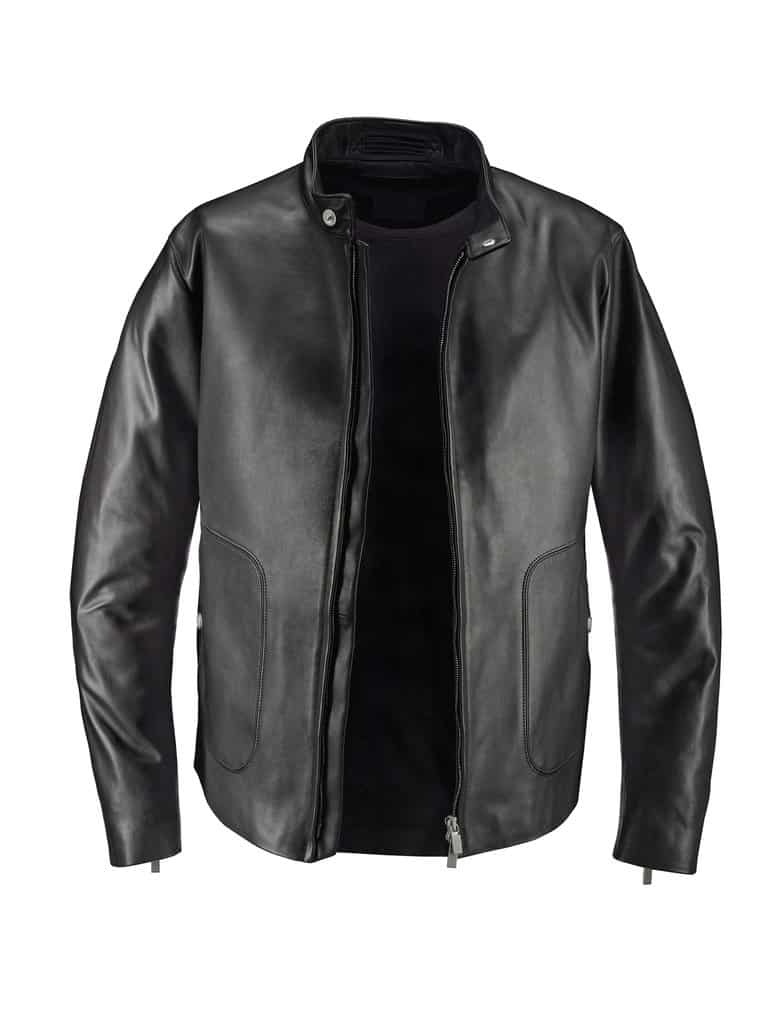Leather jackets that are brand new or too old and unmaintained are stiff and disobedient. Brand new, the leather jacket hasn’t been broken in yet and is yet to develop character. Too old and unmaintained, the leather can get dry and stiff, making it wrinkly and potentially risk cracking.
Whether your jacket is new or old, in this guide, you will learn all the ways you can soften your leather jacket and wear it confidently.
Why is my leather jacket so hard?
If you ride a motorcycle and you just bought a leather jacket such as cafe racer, this is quite a common question. As leather motorcycle jackets are made to protect and go through extreme weather conditions and even protect against accidents, they are usually made from bovine leather that is tanned specifically for durability .

Bovine is the general term for leathers that come from cattle like cowskin or cowhide leather. It is one of the toughest types yet most common types of leather used for protection and things that are exposed to adverse conditions like protecting books in bookbinding and creating rugged saddles in saddlery. Cowskin leather has even been used in armor making in historical times.
New leather jackets can also be stiff even if it’s not made from bovine leather or made from lambskin leather which is one of the softest types of leather. This is because the fibers in the leather are not used to movement yet, and the fibers need to be stretched and broken in to make them flexible. This will also create the jacket’s character and identity based on your body, use, and lifestyle.
The upper layer or higher-quality leather like full-grain leather has tighter fibers compared to the lower layers, like suede, the lowest quality leather, which has very loose fibers.
Old leather jacket becoming Stiff
Leather jackets that have not been cared for or maintained can become very stiff, and depending on how dry the storage conditions were, dry leather can even become almost like cardboard.
If you want to bring back your old leather jacket, or maybe restore a vintage find, there are ways to bring it back to its glory days.
What makes leather stiff?
The leather becomes stiff for one main reason; dry fibers. Just like how your skin can feel inflexible when it is lacking moisture, the same applies to animal hide. Real leather needs to be moisturized to keep the fibers lubricated, flexible, and healthy.
How to Soften and maintain your old leather jacket
Old leather jackets that have not been conditioned for long periods of time can become stiff and need to soften. If you notice that your leather jacket is starting to become stiff, it may be time to do some periodic maintenance to keep it feeling fresh and comfortable. There are easy methods how to break in your new leather jacket as well.
Leather conditioners and oils
Just like how humans have skin care products, there are products and oils that you can apply to relax, moisturize, and soften the leather fibers. In addition to softening, it can also add a nice finish and protect your leather jacket from severe wrinkles and cracking.
Leather softeners and conditioners
Leather conditioner is a specific finished product formulated with all sorts of ingredients that are beneficial to leather’s longevity, strength, texture, and finish. It can come in oils, creams, and waxes.
It may contain some of the oils that we will mention below, but the benefit of leather conditioners over raw oils is that it is formulated with the right amounts of multiple ingredients as an all-in-one solution for waterproofing, softening, strengthening, and finishing.
- Powerful Leather Conditioner: Leather Honey penetrates deep to protect new leather and rejuvenate...
- Restore All Types of Leather: Soften & moisturize leather furniture, car seats, shoes & belts. Great...
- Non-sticky, Odorless, Water Repellant Formula: Protect your leather all year long from snow & rain....
Oils
If you do not have a leather conditioner at the ready, that’s okay. There are ways to soften your jacket with ingredients that are more accessible or may already have nearby. Individual oils will not be able to provide an all-in-one solution, and may not protect your leather enough, so it is best to apply a wax afterward.
Olive oil and coconut oil
Olive oil and coconut oil have similar effects on leather. Fats and oils are the main ingredients in conditioners that make leather soft. They may not be great at waterproofing on their own as that is the job of the waxes.
Mink oil
Mink oil is different from the above-mentioned oils as it has the added benefit of not being greasy or leaving an overly-oily finish. It is also better at penetrating the leather fibers, making it a more efficient natural softening product. However, mink oil runs the risk of staining leather . So it is best not to apply it directly as large concentrations like drops of the mink oil left on the leather can leave stains.
Things you will need:
- Soft cloth
- Leather sponge
- Leather conditioner or any of the oils mentioned above
- Heating element
- Leather Wax like beeswax, carnauba, or lanolin (optional)
How to use oils and conditioners:
- Clean your old jacket by wiping it with a damp cloth, making sure there is no dust and hard particles that may scratch the leather when rubbing.
- Lay your jacket flat on a clean surface
- Take a cloth or leather sponge (you may also use any soft sponge) and apply a reasonable amount of the oil or conditioning cream. Wax-based conditioners may have specific instructions indicated, follow those if they are different from the process mentioned here.
- Massage the leather with the sponge or cloth, rubbing in circular motions.
- Apply a wax if the jacket is going to be subjected to adverse conditions to protect it from scratches and add a layer of protection against water.
Tips and extra information:
- Coconut oil hardens in colder climates. It is best to warm it up slightly before use. Warm it up only up until it becomes liquid, don’t let it get too warm.
- Some conditioning creams may not have much wax in them, you may apply more wax if you plan to use your jacket in extreme weather conditions.
- Spread it properly so as not to leave excess product on the leather. Less is more, you don’t want visible oiliness that can be unpleasant to touch.
Steam softening method
Steaming is another way to quickly soften your leather jacket. However, you shouldn’t just steam your jacket and call it quits. Steaming your jacket is only one part of the process, and skipping the essential care steps could ruin your jacket instead, especially when dealing with old jackets.
Heat and moisture could damage your leather jacket if not used properly, as the natural oils that make the leather flexible are easily stripped away with heat and moisture. When using steam, you should always follow up with leather care products.
Things you will need:
- Clothing steamer or fabric steamer
- A cleaning cloth
- A sturdy hanger/jacket hanger/padded hanger
- Leather conditioning products
How to soften leather with steam:
- Prepare the clothing steamer, setting it to medium-low. Make sure the steam is steady, before using. refer to the manufacturer’s instructions for the time required for it to be ready.
- Clean your leather jacket by brushing the loose dust and large particles off and wiping off the stubborn dust with a damp cloth.
- Hang the leather jacket using the padded hanger on a rugged hanging rod or coat hanger.
- Steam the entire jacket thoroughly and evenly. Be careful not to stay in one spot for too long, and move in a back-and-forth motion. Pay attention to the softness of the leather when you’re steaming. To avoid oversaturating the leather with steam, test and feel the softness and stop once it is soft enough.
- Wipe the excess water off of the surface and leave it in a cool, dry, well-ventilated room to dry out for about 2-3 hours.
- Once the leather material is dry, apply the leather care products as indicated in the Leather Conditioners and Oils section previously mentioned in this guide.
Tips and extra information:
- It is best to use leather conditioners and not just oils on restorations and maintenance, as you want more complete protection for your leather item.
- Avoid using a hair dryer to dry the leather as they can dry the leather too quickly and unevenly, leaving the lower layer too moist and the surface too dry, this can cause warping.
Alternative: spray bottle method
If you do not have a steamer, you may also use a spray bottle to wet the leather and moisten it. This method applies more water to the surface of the leather, but because of the lack of heat, it is not a huge threat to the leather. Although pay attention to the wet leather and avoid oversaturating it.
After spraying it, you may follow steps 5 and 6 above.
Conclusion
New or old, with the methods mentioned above, you never have to settle for uncomfortable stiff leather jackets. Leather jackets are like watches and jewelry, they are something you can keep for the rest of your life and can be heirloom items. Proper care can extend the life of leather items greatly.
We hope this guide has helped you learn how to make your leather jacket more comfortable and how to make it last forever.
FAQ
Is Vaseline good for leather?
Vaseline or petroleum jelly can be risky on leather products. Yes, it can soften the leather, but it should never be the go-to product for conditioning leather. Petroleum jelly can degrade adhesives and plastics that may be used in the thread for stitching.




